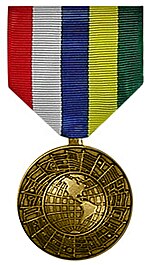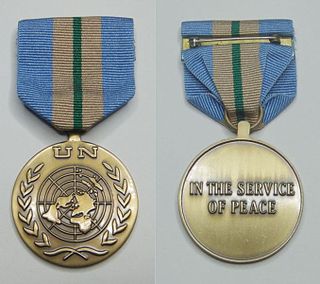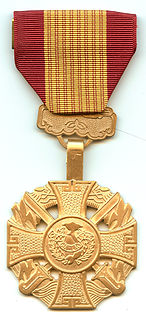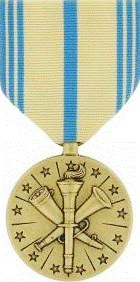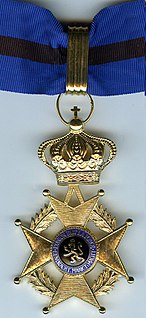| Inter-American Defense Board Medal | |
|---|---|
The Inter-American Defense Board Medal | |
| Awarded by the Organization of American States | |
| Type | International Military Award |
| Eligibility | Any soldier of a member nation's uniformed services who serves a tour of duty with the Inter-American Defense Board |
| Awarded for | Serving a tour of duty or serve on staff or as an instructor at the Inter-American Defense College |
| Status | Active |
| Statistics | |
| Established | December 11, 1945 |
Inter-American Defense Board Ribbon | |
The Inter-American Defense Board Medal is an international military award which was created on December 11, 1945, by the 91st session of the Inter-American Defense Board, a Pan-American defense group devoted to the security of the member countries of the Organization of American States.
An international decoration is a military award which is not bestowed by a particular country, but rather by an international organization such as the United Nations or NATO. Such awards are normally issued as service medals, for participation in various international military operations, and not for specific acts of heroism or bravery.

The Inter-American Defense Board (IADB) is an international committee of nationally appointed defense officials who develop collaborative approaches on common defense and security issues facing countries in North, Central, and South America. The IADB provides technical advice and services to the Organization of American States (OAS).
Pan-Americanism is a movement that seeks to create, encourage, and organize relationships, associations and cooperation among the states of the Americas, through diplomatic, political, economic, and social means.
Contents
- Usage with national military regalia of the member states
- United States
- Other similar awards
- References
- External links
The Inter-American Defense Board Medal is awarded to any military officer, serving in a member nation of the Organization of American States, who completes a tour of service with the Inter-American Defense Board. The award is also presented to military personnel who serve on the staff of the IADB Chairman, Secretariat, or for those who complete instructor tours at the Inter-American Defense College.

The Inter-American Defense College is the educational entity of the Inter-American Defense Board, an independent entity of the Organization of American States. The IADC is unique in the Western Hemisphere in that the faculty, staff and student body are international. Broad international participation provides an exceptional opportunity for the free exchange of ideas and forms a foundation for better inter-American understanding.
The Inter-American Defense Board Medal is a one-time decoration but may be upgraded with 3⁄16 inch silver and gold stars depending on the length of time an individual serves with the Inter-American Defense Board. A silver service star or bar is awarded for one year of service; a gold service star or bar for two; two gold stars or bars for between three years and five; and three gold stars or bars for more than five years service. U.S. military personnel who have been awarded the Inter-American Defense Board Medal and ribbon may wear them when attending meetings, ceremonies, or other functions where Latin American members of the Board are present. [1]
A service star is a miniature bronze or silver five-pointed star 3⁄16 inch in diameter that is authorized to be worn by members of the seven uniformed services of the United States on medals and ribbons to denote an additional award or service period. The service star may also be referred to as a campaign star or battle star depending on which award is authorized the star and the manner in which the device is used for the award.
